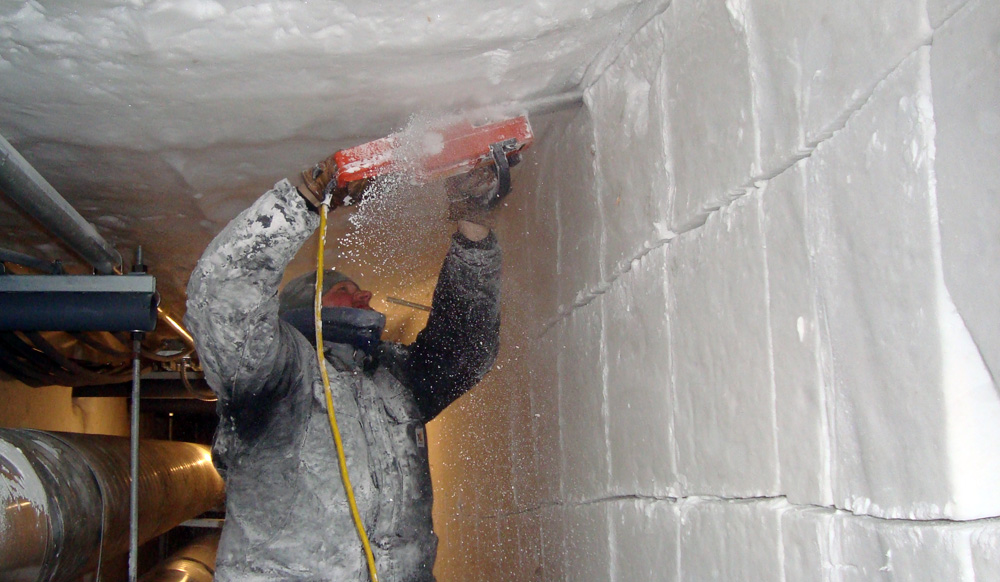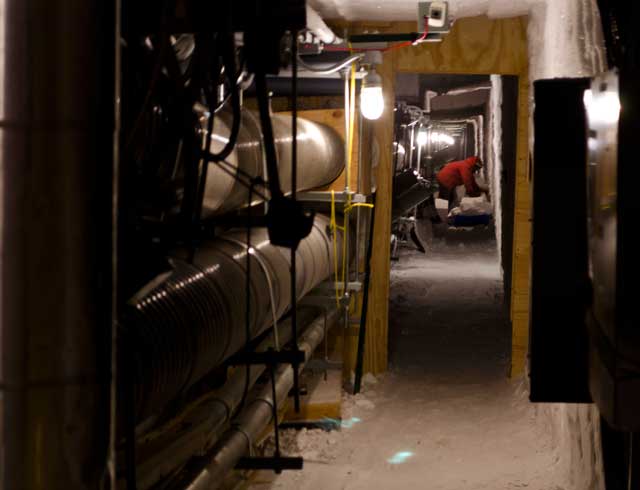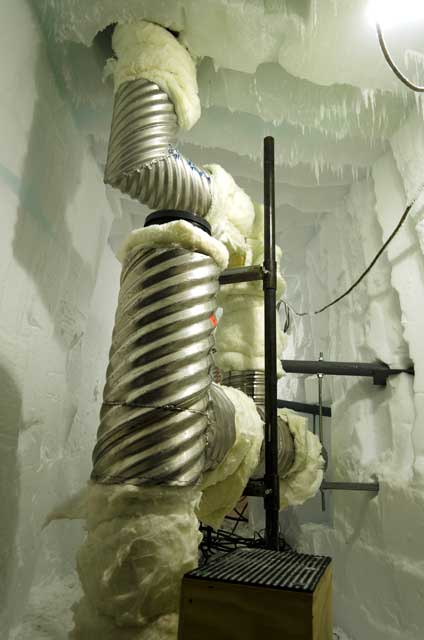Tunnel visionEncroaching ice in utility corridor below South Pole Station shaved backPosted July 11, 2014
The characteristic Styrofoam-squeak of rubber-soled boots on the compacted snow is muted in the ice tunnels below the South Pole Station. Scott Smith confidently walks farther down the tunnel that was carved by machine and man more than a decade ago, pointing out where workers have more recently been wielding chainsaws to widen the corridor where the station’s insulated utility lines run. The walls have been slowly inching their way inward over the years – about three feet in places – threatening to clog the tunnels. The main utility corridor is about 2,000 feet long, located 50 feet or more below the polar plateau surface where the U.S. Antarctic Program’s Amundsen-Scott South Pole Station “It was really becoming a safety hazard, especially if you had to pull somebody out,” says Smith, who was a plumber on the crew in the early 2000s that originally installed the piping that snakes through icy labyrinth The station’s facility maintenance supervisor, Smith is overseeing this and other projects at the South Pole Station, where up to about 150 people live and work during the short summer season. This year was more of a pilot project to determine how to most safely and efficiently chip and haul away the ice, returning the tunnels to their rough dimensions of 10 feet high by six feet wide. In the end, it’s a lot of brute force: Chainsaws, hammers and other blunt and sharp instruments are used to re-sculpt the walls and ceiling. A person then physically hauls a sled piled with chunks of ice up the slightly sloped ice tunnel, which stays at a frosty minus 55 degrees Celsius at its deepest point. “We don’t have any cool technology to apply to it,” noted Bill Coughran, South Pole Station area manager. “It’s going to be a continuous thing. We’ll do a little bit every year.” Construction of the ice tunnels for the third and largest iteration of the South Pole Station, which was dedicated in January 2008, took place over three Antarctic summers, from 1999-2000 to 2001-02. The crew at the time mainly consisted of Colorado miners, led by a man named John Wright. “When we’re done, you’ll be able to look down tunnel and see straight as a rifle,” Wright said back in December 1999 at the beginning of the three-year project. The men made use of a modified Melroe Bobcat excavator that had been tested and retested the previous decade At least that was how it was supposed to work. The tunneler, as it was called, broke down often, forcing the workers to resort to chainsaws and pick axes, just like miners tunneling through a Colorado silver mine. A number of shorter tunnels branch from the main corridor, connecting to current and future wells within the ice where the station receives its fresh water and sewage bulbs where waste is stored. The freshwater cavity is called a Rodriguez well, or Rod well, named after the Army engineer, Raul Rodriguez, who developed the system at Camp Century in Greenland during the early 1960s. Rod wells have been used at the South Pole Station since 1995. The first water well was installed by U.S. Army Cold Regions Research and Engineering Laboratory (CRREL) The current well, Rod well #3, was brought online less than two years ago. A Rod well is created by forming a cavity several hundred feet beneath the surface and maintaining a pool of heated water throughout the well’s lifespan. The bulb-shaped pocket gradually expands as the walls continually melt away, creating a constantly renewing source of water. Eventually, a new well is needed when the cavity reaches about 500 feet in depth because it takes too much energy to pull the water up and recirculate it. In turn, the abandoned rod well then becomes the primary sewage outfall. “There should be enough capacity for 10 to 15 years,” Coughran says of the new sewer bulb, which was completed during the 2013-14 summer season. End is near for Summer CampThe reduced summer population at the South Pole Station should help extend the life of those utilities. Two years ago, the station dropped down to about 150 support personnel and researchers during the months of November to February when the facility is safely accessible to aircraft. Previously, the population had topped out at 250 or more. [See previous article — Moving along: South Pole Station settles into operational mode five years after official dedication.] There are signs that the “new normal,” as Coughran calls it, will be permanent. The latest is the demolition of the so-called Summer Camp, a collection of Jamesway huts constructed of wood and specially treated insulated blankets that were first used in the Aleutian Islands during World War II. “It is the end of an era,” Coughran says of summer camp, located in an area that became known as Altie Meadows, named after Altie Metcalf, an employee in the National Science Foundation’s then-Office of Polar Programs 
Photo Credit: Peter Rejcek
Flooring for one of the Jamesway buildings sits in several piles. The structure may have originally come from another U.S. station called Ellsworth that was built in the 1950s.
At its peak, summer camp consisted of about a dozen heated tent buildings, as well as several other structures, to accommodate upwards of 100 additional people. About a half-dozen buildings were disassembled during the recent summer season. [See related article — Frontier living: Historic Jamesways have been part of South Pole Station since 1950s.] The demolition of the Jamesways has turned up a couple of historical curiosities. The flooring of the huts, which doubled as the packing crate for the structures, were stamped with the word “Ellsworth.” Ellsworth Station was one of seven U.S. facilities established during the International Geophysical Year (IGY) An avid polar philatelist, Smith Sometimes the rooms would be sweltering warm near the ceiling but bottles of water on the floor would freeze. “Living in the new station is pretty plush,” he says. |



For USAP Participants |
For The Public |
For Researchers and EducatorsContact UsU.S. National Science FoundationOffice of Polar Programs Geosciences Directorate 2415 Eisenhower Avenue, Suite W7100 Alexandria, VA 22314 Sign up for the NSF Office of Polar Programs newsletter and events. Feedback Form |







